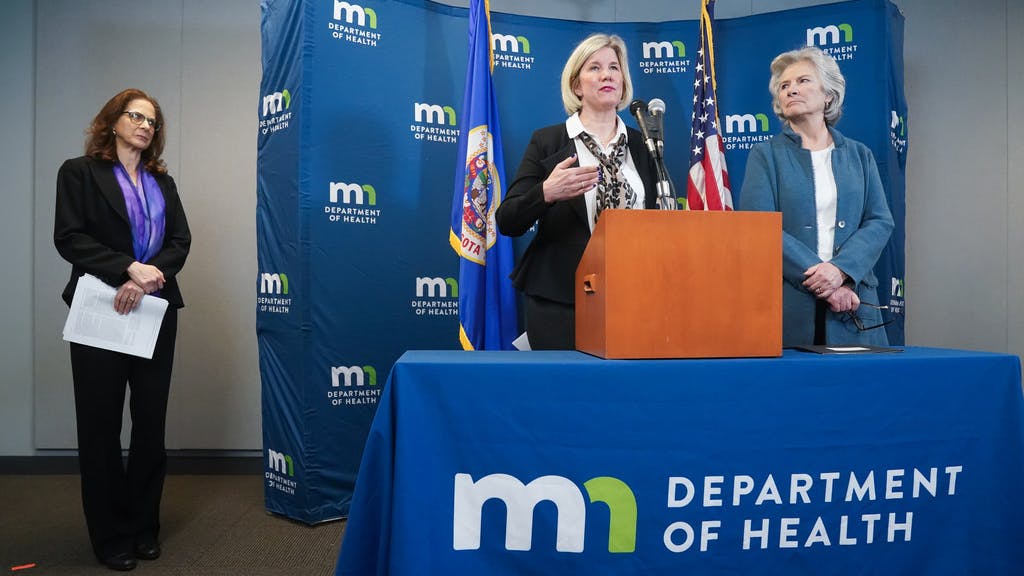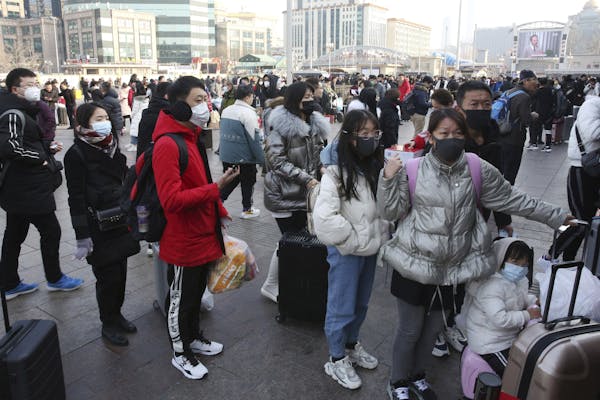State and federal health officials on Friday announced steps to confront the global spread of a novel coronavirus that emerged in China last month, following the discovery of a second confirmed U.S. infection and 63 suspected cases — including two in Minnesota.
The Minnesota Department of Health issued an alert to doctors and other health care providers this week asking them to notify authorities about any patients with respiratory symptoms or fevers who recently traveled in Wuhan, China. Callbacks from Minnesota doctors resulted in state officials sending two lab samples from suspect patients for testing at the U.S. Centers for Disease Control and Prevention.
The two suspected Minnesota cases involve travelers who had visited Wuhan recently. Both have received medical attention but did not need to be hospitalized. They are isolated at home while state health officials await test results from the CDC and reach out to people with whom they have been in contact, said Kris Ehresmann, infectious disease program director for the state health department.
"We've identified their contacts, and so we're beginning to follow up with those individuals to see if they have symptoms of illness and to limit their activities" as needed, she said.
At the University of Minnesota, spring semester began Tuesday, with more than 2,200 Chinese international students recently returned from China. While the U said it will work closely with the state health department to monitor any developments, it stressed that there are no confirmed coronavirus cases on any of its campuses, according to a public health alert.
Boynton Health, the U's Minneapolis clinic, will ask patients with fever or respiratory symptoms about overseas travel.
Health officials stressed that Minnesotans in general are at "low immediate health risk" from this virus, known as 2019-nCoV, unless they have traveled recently to China. However, they said it is important to limit the spread of the new coronavirus, which was first transmitted from human contact with animals at a fish market in China, but has now spread from person to person and could become even more hazardous.
"Viruses have the potential to mutate, sometimes very quickly, which is why containing the spread and stopping the virus … is such a critical public health prevention approach," said Jan Malcolm, state health commissioner.
The CDC has confirmed two cases among U.S. travelers returning to Washington state and Illinois from Wuhan. Lab tests have ruled out infection in 11 suspect cases and are ongoing in the remaining suspect cases, the CDC reported on Friday.
In the two confirmed U.S. cases, the travelers returned from China before their symptoms emerged. CDC officials said that sort of lag could make it hard to catch cases via airport screening. The CDC advised that no Americans take non-essential travel to Wuhan, and to take public health precautions such as wearing masks and washing hands while traveling to other regions of China.
"This is what we are preparing for," said Dr. Nancy Messonnier, CDC's director of the National Center for Immunization and Respiratory Diseases (NCIRD). "We have an aggressive response with a goal of identifying these cases early."
While coronaviruses are common causes of colds, new strains are troubling for public health officials because they can spread rapidly among people who have no immunity to them. People who are elderly or have existing medical conditions might suffer more severe illnesses from this infection, said Dr. Ruth Lynfield, state epidemiologist.
The global SARS outbreak, which caused 774 deaths in 17 countries from 2002 to 2004, was due to a novel coronavirus, according to the World Health Organization. At the peak of the SARS outbreak in 2003, Minnesota had 11 suspected and probable cases. Many of those cases had alternative diagnoses that could explain their symptoms, however.
Some health officials have predicted that this new coronavirus will spread faster but cause milder symptoms than SARS, but Messonnier said there is still much that is unknown about this outbreak.
Screening at airports in Chicago, New York, Atlanta, Los Angeles and San Francisco is checking broadly for anyone returning from China with fever, cough and other respiratory symptoms, though such symptoms are common this time of year due to the spread of influenza and other viruses, she said.
The Illinois case involved a Chicago woman in her 60s who returned from the Wuhan region on Jan. 13. The woman is in stable condition and appears not to have interacted closely with others or used public transportation or attended public events since her return, said Allison Arwady, Chicago public health commissioner. She was placed in isolation at a hospital in Chicago shortly after discussing her symptoms and travel history with her doctor. "That is reassuring," Arwady said.
Health officials urged recent travelers from China with respiratory symptoms to call their doctors first before going into clinics, so they can be diverted if necessary to hospitals or clinics that are equipped to handle infectious diseases and to limit their contact with others.
Ehresmann said it appears this coronavirus can spread when an infected person sneezes on someone else but isn't as contagious as a virus such as measles, which can "actually hang in the air." She stressed that average Minnesotans aren't at risk unless they recently traveled to Wuhan or were around such a traveler who is now ill. "The likelihood that your symptoms have anything to do with this novel coronavirus are exceptionally low," she said. "You should be thinking about influenza and the common cold."
Staff writer Glenn Howatt and Michelle Griffith, a University of Minnesota student on assignment for the Star Tribune, contributed to this report.
Jeremy Olson • 612-673-7744

Trail section at one of Minnesota's most iconic spots closing for rehab

Will 'shotgun only' zone for deer in southern Minnesota be abolished?

Four Minnesotans catch salmonella in outbreak linked to basil sold at Trader Joe's


